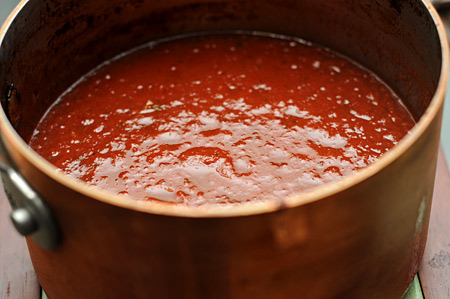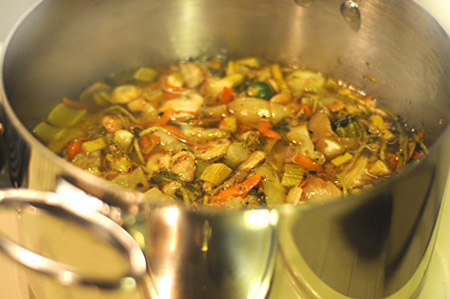I’ve got a bunch of my friends asking me how come my tomato sauce tastes so rich and has such a rich deep flavor. I am going to go over a few tricks here, but put it short and sweet: I do not put too much stuff in my tomato sauce, and I stew it for hours. Ok, I hear people talk about how they cook tomato sauce (that is sauce for pasta, gnocchi, pork) and I get scared. I mean sometimes there is a list of ingredients that tops a vegetable isle in Whole Foods! It’s tomato sauce. Period. Not tomato and pepper sauce, not tomato, pepper, onion, sausage and whatever else sauce. Not to say there is something wrong with those sauces – they are just not a TOMATO sauce!
My most important tricks to making a rich, thick and flavorful tomato sauce that is as old-world Italian as it gets are very simple:
1. Superb Tomatoes, like San Marzano, or other good Italian brand plum tomatoes in their own juice, unsalted, nothing else added to them. Please check to see that there is nothing added: stores these days love adding all kinds of shit to canned food.
2. Few other ingredients / spices. I actually make different combination practically every time I cook my sauce, but here is my classic recipe.

My Tomato Sauce
Ingredients:
San Marzano tomatoes (1 large can)
Fresh basil leaves (8-10) or a tsp of dried basil, or tsp of dried oregano, or both.
A decent amount of olive oil (2-3 tablespoons)
1 tsp salt + 2 tsp of sugar (adjust that to your own taste)
2 tsp of tomato paste dissolved in ½ cup of water
¼ cup of red wine
(If, and only if I want to make it spicy for shrimp and other seafood dishes, I will add 1 – 2 dried chilies)
3. Process tomatoes using a food processor. Do not dice, cut, chop, whip or blend your tomatoes. Just use a good old-fashioned food mill!
4. Stew it for around 6 hours on low heat.
5. Use the right saucepan. I use 2.5 mm thick copper 2.5 qt saucepan – there’s something about copper pots – they just make sauces creamier. Cast iron saucepan, like Le Creuset will do quite well also, along with maybe a very heavy-duty stainless steel pot. DO NOT use light cookware to make this: it will most likely burn the sauce.
Process:
I heat the oil first, making sure it’s hot but not smoking. If I choose to use a chilly I will add it now and leave it for a few minutes on lower heat to infuse the oil. If not, I will add processed tomatoes and bring them to a light simmer, add basil /oregano, salt and sugar. Add tomato paste & wine, close the lid with a slight crack to it to allow some evaporation and stew for 5-6 hours, stirring at hour intervals or so.
This sauce is great on:
Pasta, gnocchi, polenta, toasted baguette, pork or chicken.
